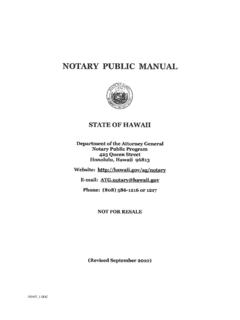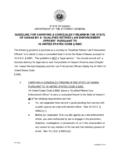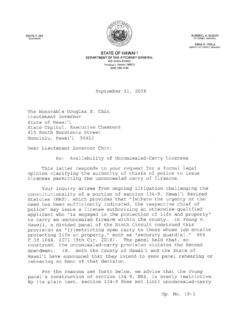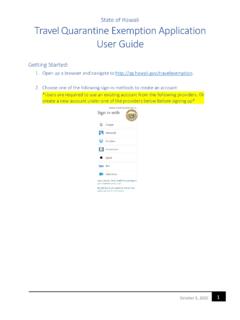Transcription of PART IV Case Studies and Practice Exercises
1 99 Prevention, Intervention, and RecoveryPART IVCase Studies andPractice ExercisesThese case Studies have been prepared to provide specific risk and threatfactors for examination and to create useful learning tools. They are intendedto provide assistance to organization planners as they develop workplaceviolence prevention programs and assess their readiness to handle these typesof situations. The characters in the case Studies are fictional and have beencreated for educational purposes. No reference to any individual, living ordead, is intended or should be Violence100101 Prevention, Intervention, and RecoveryThe call comes s being stalked two employees get into a shovingmatch a woman flees a violently abusive mate a sometimes-disoriented employee keeps showing up at coworkers homes asupervisor s constant abuse infuriates a subordinate an em-ployee in a fit of rage destroys company property a fired em-ployee makes a direct are just a few examples of the types of incidents that can happen inthe each employer responds to these reports will differ, not only amongdifferent organizations, but sometimes within the same organization.
2 Depending upon the circumstances of each situation. Even in organiza-tions with highly structured, well-thought-out procedures in place, thehandling will have to depend on: The nature of the incident; The circumstances surrounding the incident; Who is available to respond; Who has the skills to deal with the particular has been learned from many years of experience in the Americanworkplace is that the most effective way to handle these situations is totake a team approach, rather than having one manager, function or officehandle situations using a team approach is laden with problems. In some cases ofworkplace homicide, it became apparent that the situation got out ofcontrol because human resources managers did not inform security abouta problem employee , coworkers were not warned about the threateningbehavior of an ex- employee , or one specialist felt he had to go it alone in handling the situation.
3 Also, presenting all cases to a team to considerlessens the chance that one person s denial of reality could result in afailure to StudiesWorkplace Violence102A team allows for the linking of multiple disciplines and experience-basesfor use in the examination and management of potentially dangerouscircumstances. Where available, management, human resources, em-ployee assistance program, security, union, legal, and psychologicalservice representatives should be considered for inclusion on the team. Incases where the full range of resources are not part of the organization,outside consultants are often pre-identified and join the team whencritical cases are being handled. This would typically be the case insmaller organizations without in-house attorneys, psychologists, securitypersonnel, or threat management should have plans in place ahead of time so that emergencyand non-emergency situations can be dealt with as soon as , it is also necessary to build the maximum amount of flexibilitypossible into any organizations and situations differ, a list of specific steps or proce-dures to follow in all workplaces would be inappropriate and , there are some basic concepts that all employers should keepin mind when formulating a strategy to address workplace violence: Respond promptly to immediate dangers to personnel and the work-place.
4 Investigate threats and other reported incidents. Take threats and threatening behavior seriously; employees may notstep forward with their concerns if they think that management willdismiss their worries. Deal with the issue of what may appear to be frivolous allegations (andconcerns based on misunderstandings) by responding to each reportseriously and objectively. Take disciplinary actions when warranted. Support victims and other affected workers after an incident. Attempt to bring the work environment back to normal after an any kind of team to work well in actual tasks, be it in sports or crisismanagement, it is important that the team develop its approach tocommon situations. In all teams, including those formed to lead organiza-tions responses in situations involving workplace violence, training andgroup Practice are key factors to real-world success.
5 It is important that aworkplace violence management team discuss possible situations andworkable solutions before being assembled for actual situations. Thisallows for coordination and feasibility issues to be worked out in ConceptsForming theteam s approach103 Prevention, Intervention, and RecoveryThese case Studies have been prepared to provide specific risk andthreat factors for examination and to create useful learning are intended to provide assistance to organization planners asthey develop workplace violence prevention programs and assesstheir readiness to handle these types of situations. The characters inthe case Studies are fictional and have been created for educationalpurposes. No reference to any individual, living or dead, is intendedor should be you read the case Studies keep in mind that there is no one correctway to handle each situation.
6 The case Studies should not be taken asspecific models of how to handle certain types of , they should be a starting point for a discussion and exploration ofhow a team approach can be instituted and adapted to the specific needsof each organization. A successfully used alternative may not be useful inother instances, and there are probably several different approaches thatcould be equally useful. Each group in its discussions should strive toidentify several workable case Studies are intended to raise questions such we agree with the approach the employer took in the casestudy? not, why wouldn t that approach work for us? other approaches would work for us? we have adequate resources to handle such a situation?
7 Establish a system to evaluate the effectiveness of a response in actualsituations that arise so that procedures can be changed as necessary. Askthe following questions after reviewing each of the case Studies and afterplanning how your organization would respond to the same or a our workplace violence prevention program have a processfor evaluating the effectiveness of the team s approach followingan incident? our written policy statement and written procedures limitour ability to easily adopt a more effective course of action in thefuture, if an evaluation of our response showed that a change inprocedures was necessary? we have plans to test our response procedures and capabilitythrough Practice Exercises and preparedness drills, and to changeprocedures if necessary?
8 Questions for discussionQuestions for programevaluationHow to Use the CaseStudiesWorkplace Violence104 case Study 1 - A Threat A top executive of a major company telephoned the Director ofSecurity and explained that he had just received a threateningmessage. The message was constructed from words and letters cutout of a magazine and glued to a piece of paper. The messageindicated that the executive would be killed. Later, the sameexecutive received a dead cockroach taped to an index card witha straight pin through the body. The message written on the cardwas, .. This could be you ..The Company s president, Director of Security, and Corporate Counselimmediately conferred and reviewed the facts regarding the situation anddeveloped a course of action.
9 They concluded that other law enforce-ment agencies should be brought into the case . They also decided thatspecial physical security measures must be taken immediately to protectthe Company had a total population of over 21,000 people, whichincluded employees, visitors, and guests. The executive could not narrowthe list of suspects. Over the next several months, the executive receivednumerous unsolicited items in the mail at his office and home. The Inspector was contacted to assist in the case . The original requestsfor the unsolicited items were retrieved and handwriting samples ob-tained. The investigator compared the sample with thousands of notesand documents written by a year later, several employees expressed concern overreceiving harassing unsolicited items in the mail.
10 The original requestswere obtained and it was concluded that they were made by the sameindividual. The employees were asked to list the individuals that theybelieved to be the most likely suspect. One name appeared on all thelists. The investigator obtained previously prepared handwritten docu-ments and the handwriting appeared to be that of the same person. Theinformation was turned over to a special investigative team with anotherlaw enforcement agency who brought the individual in for individual denied writing the threatening notes or being responsiblefor the harassing mail. Finally, the individual relented and provided thehandwriting samples, then returned to his desk at his office where he thencommitted suicide.








